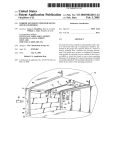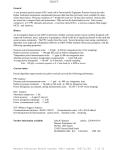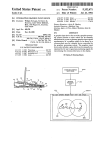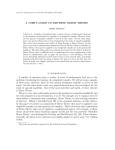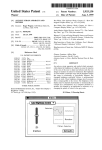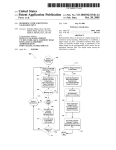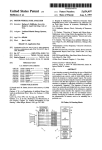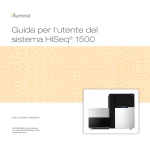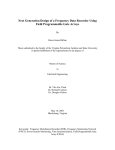Download J ) I5 ,6)`
Transcript
US006644098B2 (12) United States Patent (10) Patent N0.: (45) Date of Patent: Cardinale et al. (54) HEATED ELECTRODE REFRIGERANT DETECTOR UTILIZING ONE OR MORE CONTROL LOOP 4,171,341 A 4,203,199 A 4,237,721 (75) Inventors: Dennis Cardinale, Plantation, FL (US); Robert Zubik, Miami, FL (US) (73) Assignee: Advanced Test Products, Inc., Miramar, FL (US) (*) Notice: Subject to any disclaimer, the term of this patent is extended or adjusted under 35 U.S.C. 154(b) by 159 days. (21) Appl. No.: 09/838,169 Apr. 19, 2001 (22) Filed: Prior Publication Data (65) US 6,644,098 B2 Nov. 11, 2003 10/1979 Morgan ..................... .. 422/98 5/1980 Morgan .... .. 29/612 A * 12/1980 4,244,918 A * 1/1981 4,298,573 A * 4,305,724 A Dolan .. ... ... ... . Yasuda et al. .. 11/1981 Fujishiro 12/1981 Micko . . . .. 73/23.2 ..... .. 422/95 . ... ... . . . . . .. 422/94 . . . . . . . . . . . . . . . . .. 23/232 4,327,054 A * 4/1982 Yasuda et al. .. ..... .. 422/95 4,520,653 A * 6/1985 Kaiser .. ... ... ... . . . . .. 73/23.2 4,609,875 A 9/1986 Jeffers .. ... ... ... . . . . .. 324/455 4,879,546 4,910,463 5,104,513 5,198,774 A A A A 11/1989 3/1990 4/1992 3/1993 Dunham et al. .......... .. Williams, II et al. ..... .. Lee et al. ................. .. Williams, II et al. ..... .. 340/632 324/468 204/425 324/468 5,226,309 A 7/1993 Stetter et al. 5,284,569 2/1994 A Lee et al. 73/31.06 ....... . . . .. 204/425 5,297,419 A * 3/1994 Richardson 73/2503 5,351,037 A 9/1994 Martell et al. ............ .. 340/632 (List continued on neXt page.) OTHER PUBLICATIONS US 2002/0092341 A1 Jul. 18, 2002 YokogaWa Corporation of America—Operation Manual for Top Gun, Model No. H10Xpro “Refrigerant Leak Detector”, Related US. Application Data (60) Provisional application No. 60/262,525, ?led on Jan. 18, (51) Int. c1.7 ...................... .. H05B 39/04; G01N 27/04; (8 pages). 2001. Leybold In?con Inc.—User’s Manual for D—TEK Refriger an‘ Leak Damon (10 Pages) GOlN 27/407; GOlN 27/46; GOlN 33/22 (52) U-S. Cl. .................. 422/90; .. 422/98; 422/109; 324/443 (58) Field of Search ........................... .. 73/2501, 25.05, Primary Examiner—Helen KWok Assistant Examiner—David J. Wiggins Attorney) Or Firm_Baker & Hostetler (57) ABSTRACT _ 73/232, 3105; 422/98, 90, 109; 324/98, A gas detector for' sensing' the presence of at~least one 109, 610, 464, 443_444 predetermined gas is operative in con]unct1on With a elec trical poWer source and includes a detection circuit, a (56) References Cited temperature controller, and a electrical current controller, Us‘ PATENT DOCUMENTS Wherein the detection circuit includes a sensing device havmg ?rst and second electrodes, the ?rst electrode being 2,404,474 A * 7/ 1946 Collins -------------------- -- 73/25-01 3,347,635 A * 10/1967 McKee ---------------- ~~ 23/232 E connected to the poWer source for heating the ?rst electrode, the temperature controller is operatively connectable to the 3,449,939 A : 3’6O7’O84 A detection circuit for maintaining a temperature of the ?rst electrode at a predetermined magnitude, and the current 3,616,678 A * 6/1969 Monomakho? 9/1971 MadFey et a1‘ 11/1971 BatZies . . . . . . . . . . . . . 3,739,260 A 3,912,967 A 6/1973 Schadler . . . . . . . 10/1975 Longenecker 3,991,360 A 11/1976 4,151,641 A 4,157,311 A 5/1979 "" " 73/2501 23/232 E Orth et al. Mitoff . . . . .. 73/2501 t . . . .. 324/33 315/107 ........ .. ... ... .. . . . .. 324/33 . . . .. H . t. 1 \ ALARM 26' a 28 I4 36 - MODULAR)! J) 1P 3B I5 , d t 20 Claims, 3 Drawing Sheets ‘I’ \2- th predetermlned magnlmde 54 I2 t 29/611 6/1979 Orth et al. ................ .. 252/408 32 "I H t b1 t. . .t ‘£30m r0 ,er 1? 9pm We y Com?“ 1 e O ‘:1 616C 10% clrcul or mamwmng a ‘furrent 1“ t e 5660“ “CH0 6 at a » ,6)‘ \ \ 52 US 6,644,098 B2 Page 2 U.S. PATENT DOCUMENTS 5,400,015 5,444,435 5,448,905 5,490,413 5,608,384 5,841,021 A A A A A A 5,858,739 A 5,897,836 A Martell et al. .............. .. 422/90 ' Liebermann .............. .. 340/632 5,932,176 A 5 969 231 A Yannopoulos et al. ...... .. 422/98 .. 73342263? 6,085,576 A Sunshine et al. ........ .. 73/29.01 . 6,289,719 B1 * Bloemer et al. ......... .. 73/23.21 6,336,354 B1 Suzuki et al. ............ .. 73/31.05 3/1995 8/1995 Williams, II et al. 9/1995 Stetter et al. 2/1996 3/1997 Tikijian ......... .. 11/1998 De Castro et al. * 1/1999 Williams ----- /73)40 " 340/632 Qu et al. ................. .. 73/31.05 * 73/23.2 .................. .. 436/151 * cited by examiner U.S. Patent Nov. 11,2003 Sheet 2 of3 1:0) 54 1: I’ ,2 .3. “5W sun I8‘ 20\ mum: my _ mm vcms: rummu EE'ZEELEEH- a 28 T W k 50 MS a PROCESSING ~—“"5 62 mum as '’ * ‘000mm: ,5 I67 ‘\ ‘19 - ‘6*, _,/K54 ,8 36 . US 6,644,098 B2 szcono * um V ? I nocissme ‘ 0 7 46 FIG 4 Kg 1a\ mm 20\ PROCESSOR ' “m x 52 U.S. Patent Nov. 11,2003 L9 42\ Sheet 3 of3 US 6,644,098 B2 I£5.___..____.____. /a\ HIST ' vomss POTENTIAL CDNVERTE! PURPOSE PROCESS‘NG "I-.l'Ju US 6,644,098 B2 1 2 HEATED ELECTRODE REFRIGERANT DETECTOR UTILIZING ONE OR MORE CONTROL LOOP in temperature are frequently misinterpreted as an indication of the presence of halogenated molecules because their respective effects are the same: each causes an increase in the bias current of the sensor. U.S. Pat. No. 4,305,724 to Micko (the “’724 patent”) CROSS-REFERENCE TO RELATED APPLICATION discloses a combustible gas detection system including a sensor temperature control system. The detection system This application is entitled to the bene?t of, and claims priority to, Us. patent application Ser. No. 60/262,525, ?led Jan. 18, 2001 and entitled “HEATED ELECTRODE REFRIGERANT DETECTOR UTILIZING ONE OR MORE CONTROL LOOP.” 10 includes a sensor element having active and reference sen sors for detecting combustible gases, a controlled current source for providing electrical poWer to the sensor element, a voltage-to-duty cycle converter for providing a square Wave control signal of variable duty cycle and a bypass sWitch for bypassing the active sensor element in response BACKGROUND OF THE PRESENT INVENTION to the control signal. By increasing or decreasing the duty 15 1. Field of the Present Invention The present invention relates generally to the ?eld of gas sensors, and, in particular, to the art of detecting halogenated to cause the temperature of the active sensor to increase, the refrigerants by applying control theory to an improved “heated electrode” technology to control the operation of the 20 detector using an advanced sensing device and one or more increase is detected by the temperature control system and the duty cycle is adjusted to counteract the increase and maintain the temperature constant. control loops. 2. Background Art Gas detectors for sensing the presence of halogenated cycle, the amount of electrical energy ?oWing to the active element is likeWise affected and the temperature of the active sensor may correspondingly be either upWardly or doWn Wardly biased. When the presence of combustible gas begins Unfortunately, the detection system of the ’724 patent suffers from some draWbacks. First, the detection system of 25 the ’724 patent requires the use of a reference sensor. gases and other gases are Well knoWn. FIG. 1 shoWs prior art Perhaps more importantly, the temperature control system is gas detector type suitable for this purpose, commonly used only to equaliZe the temperature of one sensor With referred to as a “heated electrode” sensor. This sensor respect to the other sensor. In particular, it includes no means utiliZes a cathode Wire and an anode Wire made of platinum, for measuring the absolute temperature of either sensor, or palladium or an alloy thereof. Typically, the cathode is 30 repeatedly coated With a ceramic material such as a mixture of an alkali metal silicate and oxides of aluminum or silicon, With a drying period betWeen each coat, and then inserted into an anode coil formed by several turns of the anode Wire. The anode/cathode assembly is then coated further With the same mixture, except for the ends of the anode and the exposed end of the cathode, and dried. After the ?nal drying, the anode/cathode assembly is ?red in a kiln and then installed in a housing, With the exposed ends of the anode and cathode connected to anode contacts and a cathode contact, respectively. The ?nal assembly is then energiZed the gas sought may generally be indicated merely by the heat given off by the oxidation process, as indicated by the 35 40 45 using the temperature control system of the ’724 patent Would still be affected by ambient conditions because it is incapable of controlling the absolute temperature of the sensor. In addition, the absolute temperature of the sensor cannot be controlled to prevent damage during Warm-up of the system and the like. Thus, a need exists for a temperature control system suitable for use With a heated electrode refrigerant detection system Which does not make use of a reference sensor and Which may be utiliZed to control the absolute temperature of the heated electrode. exposed to reactive gases like halogen, ions ?oW across the depletion Zone and the conductivity of the device is increased. Thus, the presence of halogenated gases may be determined by monitoring the current generated through the second electrode, referred to as the bias current, for a sudden US. Pat. No. 3,912,967 to Longenecker (the “’967 patent”) discloses a circuit for providing regulation of the increase in magnitude created by introducing the device to 55 trical poWer requirements and good sensitivity, and such sensors exhibit excellent selectivity in that they tend to ignore most chemical vapors Which may be present in a of the ’724 patent impervious to ?uctuations in absolute temperature due to ambient conditions. HoWever, in heated electrode refrigerant detector systems, the presence of the gas sought is indicated generally by an increase in bias current, Which is also affected by the ambient temperature of the sensor. As a result, a heated electrode refrigerant sensor ions develops along the electrodes. When this layer is such gases. These sensors are commonly utiliZed by tech nicians to determine Whether a refrigerant leak exists and to pinpoint its source. Advantageously, heated electrode sensors have loW elec temperature of the active sensor compared to that of the reference sensor. This characteristic makes the active sensor and biased over many hours by applying a electrical current through the anode coil and a voltage across the anode coil to the cathode Wire. The ceramic forms an electrically resistive layer betWeen the electrodes. When heated by an electrical current passing through a ?rst of the electrodes, an outer layer depleted of for independently setting the absolute temperature of either sensor to a particular chosen value. This is suf?cient in the active sensor type of the ’724 patent because the presence of 60 absolute temperature of a heater-anode of a refrigerant gas sensor. A poWer supply outputs tWo different DC voltage levels, one of Which is connected through a transistor sWitch to the heater-anode coil of a heated electrode gas sensing element. The circuit monitors the approximate absolute temperature of the heater-anode based on its effective resis tance. When the absolute temperature of the heater-anode typical test environment, as Well as Water vapor. drops enough beloW a desired value, a temperature regula Unfortunately, prior art heated electrode sensors also suffer a number of draWbacks. First, and most signi?cantly, the bias current is dependent not only upon the presence or tion circuit closes the sWitch, and a greater amount of current absence of halogenated molecules at the electrodes, but by the temperature of the device as Well. Thus, sudden changes 65 is supplied to the heater-anode. When the temperature of the heater-anode reaches the desired value again, the tempera ture regulation circuit opens the sWitch and a lesser amount of current is supplied to the heater anode. Thus, as the US 6,644,098 B2 3 4 temperature of the sensing element ?uctuates, greater or lesser heating may be applied to the heater-anode by the sensor at a highly elevated temperature and seriously reduc ing the life of the neW sensor. An improved sensor Which temperature regulation circuit. Unfortunately, although this continually and automatically adjusts the operation of the circuit provides some control over the absolute temperature of a heated electrode refrigerant sensor, the regulation is electrode to provide sufficient sensitivity over an extended lifetime of the sensor is needed. relatively crude, effectively permitting control only by turn US. Pat. No. 3,739,260 to Schadler (the “’260 patent”) ing an auxiliary heat source on and off. At best, the tem perature of the sensor is thus roughly held in a general range, discloses a method of operating a halogen detector of the With the upper approximate limit being the desired tempera ture and the loWer approximate limit being the temperature through a current setting means to the electrode to heat the heated electrode type. A current supply unit supplies current 10 at Which the transistor of the sWitch is cool enough to alloW at the electrode causes an increase in the ion current Which the auxiliary poWer supply to be coupled in. At Worst, hoWever, such a crude controller may alloW the temperature of the sensor to oscillate Wildly and even dangerously under certain conditions. Further, the circuit alloWs no adjustment to be made to the triggering temperatures at Which the is ampli?ed and its magnitude indicated by an indicator and/or an alarm. In addition, another ampli?er is connected 15 auxiliary source is turned on or off. Thus, a need exists for a more sophisticated temperature control system suitable for use With a heated electrode refrigerant detection system Which alloWs the temperature of the sensor to be rigidly maintained at a particular absolute value, rather than Within a Wide range of temperatures, and Wherein that value is adjustable. Another disadvantage of prior art heated electrode sensors is that their lifespans are frequently limited much more than anode, thus creating a fundamental ion current ?oW betWeen the anode and the cathode. The presence of halogenous gas 25 is necessary. It is Well knoWn that the operation and lifespan of heated electrode sensors are limited by the number of alkali ions in the sensor. It has been found that the bias current and the rate of depletion of ions are directly related to each other. Thus, as the sensor is used, the ions are depleted, and When no ions are left at all, the sensor is in a feedback loop betWeen the output of the electrode and the current setting means. When the magnitude of the ion current varies by a predetermined amount, the variable gain ampli?er supplies a signal to the current setting means to adjust the heating supply current to the anode in a direction to counteract the variation. Unfortunately, the detector of the ’260 patent suffers from some serious draWbacks. First, because at poWer-on there is typically a leakage current Which ?oWs through the electrode, the feedback loop Will operate to adjust the supply current to maintain the ion current at the level of that leakage current. It has been discovered that the leakage current is due to the absorption of moisture While the detector is not in use, and is generally many times larger than the bias current required for normal operation. Therefore, the “variable gain ampli?er” described may never provide enough gain at poWer-on to raise the temperature of the sensor to its desired operating point. Signi?cant limitations are also placed on the performance of the detector of the ’260 patent by the means by Which a “dead.” Unfortunately, the sensitivity of the sensor is directly related to the bias current, and so the greater the sensitivity of the sensor, the more quickly the sensor is used refrigerant is detected. More particularly, not only is the ion current being controlled by the feedback loop, but it is also up. Prior art heated electrode sensors fail to take these 35 the process variable Which is monitored for a condition indicating the presence of halogen molecules. characteristics into account and are thus used up more Unfortunately, such an approach mandates the use of inher quickly than is necessary. In addition, the exposure of prior ent high-pass ?ltering artifacts that reduce a signal level change into a time-varying peak Which lasts only a certain period of time, even though refrigerant may still be present art sensors to high concentrations of refrigerant, even for a relatively short period of time, causes a correspondingly high bias current Which results in an immediate reduction in sensor sensitivity and a considerable shortening of the sensor’s lifespan. This effect is knoWn in the industry as at the sensor. Further, the detector of the ’260 patent is designed to compensate only for relatively sloW ?uctuations of the ion current and no adjustment is made by the feedback “poisoning” the sensor, and no good solution to the problem has yet to be proposed. Finally, despite their limited lifespan, prior art refrigerant detectors provide no means of monitor ing or checking the sensor to determine its remaining life. Some solutions to these problems have been proposed. 45 mits short term, high-magnitude ?uctuations in the ion current Which signi?cantly shorten the lifespan of the sensor. For example, the H10Xpro Refrigerant Leak Detector, avail able from the YokogaWa Corporation of America of Thus, a more sensitive and longerlasting heated electrode leak detector is needed Which uses a control loop and a plurality of process variables to more reliably detect the presence of a refrigerant. NeWnan, Ga., is a refrigerant leak sensor of the heated electrode type. Like other sensors of this type, the YokogaWa sensor becomes less sensitive over time. The YokogaWa Finally, another draWback of prior art sensing devices is sensor alloWs users to increase the sensitivity of the sensor by increasing the heat Which is applied to the electrode. Because the magnitude of the bias current is dependent not only on the voltage potential betWeen the anode and cathode and the amount of refrigerant present, but is also dependent upon the temperature of the electrode, and because the loop for spikes in the magnitude of the ion current Which disappear before the end of the period of the gain ampli?er is reached. The single process variable approach thus per the length of time required to assemble and “burn in” a anode/cathode assembly. Existing methods require both the 55 anode and the cathode to be coated With the ceramic material before assembly and then further coated thereafter and require considerable periods of time for drying betWeen the various coatings. Further, prior art methods require an assembled anode/cathode assembly to ?rst be ?red in order sensitivity of the sensor is related to the magnitude of the bias current, the sensitivity of the sensor may be improved to sinter the ceramic material before biasing and the assem bly to create a depletion region. A need exists for a manu by raising the temperature of the electrode during operation of the sensor. YokogaWa alloWs this to be done by manually facturing method Which may be completed in a much shorter turning a screW a small amount, presumably to adjust the period of time than is possible using knoWn methods. operating voltage of the electrode. Further, there is a great danger that the user may forget to return the sensor tem perature to the manufacturer’s setting When he replaces a depleted sensor With a neW one, therefore operating the new 65 SUMMARY OF THE INVENTION Brie?y summariZed, the present invention relates to a gas detector having a heated electrode sensing device for sens US 6,644,098 B2 5 6 ing the presence of one or more predetermined gas and one junction With a poWer source and includes: a detection of at least one operating condition of the sensing device; and a bias current control loop for controlling the bias current generated by the heated gas sensing device on the basis of at least one operating condition of the sensing device. In features of this aspect, the temperature control loop is circuit, the detection circuit including a sensing device having ?rst and second electrodes, Wherein the ?rst elec operatively connected to a detection circuit during a ?rst mode of operation, Which may be a warm-up phase, and the trode is connected to the poWer source for heating the ?rst bias current control loop is operatively connected to the detection circuit during a second mode of operation, Which may be a normal operation phase; the controller has a sWitch adjustable betWeen at least a ?rst sWitch position in Which the temperature control loop is operatively connected to a detection circuit and a second sWitch position in Which the bias current control loop is operatively connected to the detection circuit; the position of the sWitch is determined on the basis of an operating condition of the gas detector; the or more control loops for controlling the operation of the sensing device. Broadly de?ned, the gas detector according to one aspect of the present invention is operative in con electrode; a temperature controller operatively connectable to the detection circuit for maintaining a temperature of the ?rst electrode at a predetermined magnitude; and a current 10 controller operatively connectable to the detection circuit for maintaining a current in the second electrode at a predeter rnined rnagnitude. In features of this gas detector, the temperature controller is operatively connected to the detection circuit during a ?rst mode of operation, and the current controller is operatively connected to the detection circuit during a second mode of operation; the ?rst mode of operation is a warm-up phase, and the second mode of operation is a normal operation phase; the gas detector has a sWitch adjustable betWeen at least tWo positions, Wherein in a ?rst sWitch position the temperature controller is operatively connected to the detec tion circuit and in a second sWitch position the current controller is operatively connected to the detection circuit; the position of the sWitch is determined on the basis of an 15 sensing device includes a cathode Wire, an anode Wire at least partly surrounding the cathode Wire and having oppos ing ends, a pair of supply contacts electrically connected to respective ends of the anode Wire, a pair of temperature 25 sense contacts electrically connected to respective ends of the anode Wire, and a cathode contact electrically connected to an end of the cathode Wire, and the temperature control loop is electrically connected to the temperature sense contacts; and an output of the bias current control loop is electrically connected to an input of the temperature control operating condition of the gas detector; and the sensing loop. device includes a cathode Wire, an anode Wire at least partly The present invention also includes a method of control ling a gas detector for sensing the presence of at least one predeterrnined gas, the gas detector having a heated ?rst electrode and a second electrode, Wherein the method surrounding the cathode Wire and having opposing ends, a pair of supply contacts electrically connected to respective ends of the anode Wire, a pair of temperature sense contacts electrically connected to respective ends of the anode Wire, includes the steps of: heating the ?rst electrode to a prede and a cathode contact electrically connected to an end of the terrnined absolute temperature; upon reaching the predeter cathode Wire. The present invention also includes a method of control rnined absolute temperature, placing the electrodes in a test 35 location; upon being eXposed to one of the predetermined ling the operation of a gas sensing device, the gas sensing gases, generating an increased current in the second elec device for indicating the presence of a gas of a predeter rnined type, Wherein the method includes the steps of: trode; and maintaining the ?rst electrode at substantially the predetermined absolute temperature While placing the elec adjustably heating the gas sensing device; generating a bias trodes in the test location and While generating the increased current; controlling the temperature of the heated gas sens ing device on the basis of at least one operating condition of current. the sensing device; and controlling the bias current gener steps of selecting the predetermined absolute temperature and, While the detector is being operated, providing an ated by the heated gas sensing device on the basis of at least one operating condition of the sensing device. In features of this method, the temperature controlling step includes the step of maintaining the temperature of the heated gas sensing device at a predetermined absolute temperature; the method further comprises the step of mov ing the sensing device into the presence of a gas of a In features of this method, the method further includes the 45 predetermined absolute temperature includes the step of prede?ning the predetermined absolute temperature during manufacturing; the step of providing an indication of the predetermined absolute temperature includes the step of entering the predetermined absolute temperature into the gas predetermined type, and the bias current controlling step includes the step of maintaining the magnitude of the bias detector; the amount of heat applied to the ?rst electrode is dependent on a duty cycle, and the step of maintaining the ?rst electrode at substantially the predetermined absolute current at a generally constant level during the moving step; generating a signal at least partially representative of the temperature of the sensing device and monitoring the signal for an indication of the presence of at least one predeter temperature includes the step of adjusting the duty cycle; the 55 rnined gas; the steps of controlling the temperature of the heated gas sensing device and controlling the bias current generated by the heated gas sensing device occur sequen tially; and the transition from one of the controlling steps to the other occurs on the basis of at least one operating condition of the sensing device. In another aspect of the present invention, a controller for controlling the operation of a gas detector, the gas detector for indicating the presence of a gas of a predetermined type and having a heated gas sensing device generating a bias current, includes: a temperature control loop for controlling the temperature of the heated gas sensing device on the basis indication of the predetermined absolute temperature to the gas detector; the step of providing an indication of the 65 method further includes the step of monitoring the actual temperature of the ?rst electrode, and the step of maintaining the ?rst electrode at substantially the predetermined absolute temperature includes the steps of reducing the temperature of the ?rst electrode upon determining that the actual ternperature eXceeds the predetermined absolute tempera ture and raising the temperature of the ?rst electrode upon determining that the actual temperature is beloW the prede terrnined absolute temperature. The present invention also includes a method of control ling a heated electrode gas detector for sensing the presence of at least one predeterrnined gas, the gas detector having ?rst and second electrodes, Wherein the method includes the US 6,644,098 B2 7 8 steps of: selecting a preferred absolute temperature; provid generating, at the second electrode, a bias current; generat ing a ?rst signal at least partially representative of the magnitude of the bias current, the magnitude of the bias current being a ?rst operating condition; generating a second signal at least partially representative of a second operating condition; maintaining the magnitude of the bias current at a generally constant level on the basis of the ?rst signal; and monitoring the second signal for an indication of the pres ing an indication of the selected preferred absolute tempera ture to the gas detector; adjustably heating the ?rst electrode; upon being exposed to one of the predetermined gases, generating an increased current in the second electrode; monitoring the temperature of the ?rst electrode While the increased current is being generated; comparing the moni tored temperature to the selected preferred absolute tem perature; and varying the heating of the ?rst electrode on the basis of the outcome of the comparing step. In features of this method, the step of providing an indication of the selected preferred absolute temperature includes the step of entering a value corresponding to the selected preferred absolute temperature into the gas detector; the step of providing an indication of the selected preferred absolute temperature includes the step of prede?ning the selected predetermined absolute temperature to the gas ence of at least one predetermined gas. 10 generating a second signal includes generating the second signal at one or more of the ends of the ?rst electrode; the 15 substantially continuously during operation of the gas detec tor; the selected preferred absolute temperature is a ?rst preferred absolute temperature, and the method further includes the steps of selecting a second preferred absolute temperature, providing an indication of the second selected preferred absolute temperature to the gas detector, adjust ably heating the ?rst electrode, generating an increased current in the second electrode upon being exposed to any of the predetermined gases, monitoring the temperature of the ?rst electrode While the increased current is being generated, comparing the monitored temperature to the second selected method further includes the step of moving the sensing device into the presence of one of the predetermined gases, and the maintaining step includes maintaining the magnitude detector during manufacturing; the step of varying the heating of the ?rst electrode includes the steps of reducing the temperature of the ?rst electrode upon determining that the monitored temperature eXceeds the selected preferred absolute temperature and raising the temperature of the ?rst electrode upon determining that the monitored temperature is beloW the selected preferred absolute temperature; at least the monitoring, comparing and varying steps are repeated In features of this method, the second operating condition is a temperature of the sensing device; the presence of a predetermined gas is indicated by a decrease in temperature; the ?rst electrode includes at least tWo ends, and the step of of the bias current at a generally constant level during the moving step; the step of generating the bias current includes the step of generating the bias current according to a duty cycle, and the step of maintaining the magnitude of the bias current at a generally constant level includes maintaining the magnitude of the bias current at a generally constant level according to the value of the duty cycle. 25 The present invention also includes a method of estimat ing the remaining useful life of a heated electrode gas detector for sensing the presence of at least one predeter mined gas, the gas detector having ?rst and second electrodes, Wherein the method includes the steps of: adjust ably heating the ?rst electrode to maintain a current in the 35 preferred absolute temperature, and varying the heating of the ?rst electrode on the basis of the outcome of the comparing step. second electrode of a predetermined magnitude, the magni tude of the current being at least partly dependent upon the temperature of the ?rst electrode; While heating the ?rst electrode, determining information at least partly represen tative of the operating temperature of the gas detector; comparing the operating temperature information to infor mation representative of a maXimum operating temperature; and determining the remaining useful life of the gas detector on the basis of the comparison. In features of this method, the information at least partly The present invention also includes a method for sensing the presence of at least one predetermined gas at a sensing representative of the operating temperature of the gas detec device having ?rst and second electrodes, Wherein the method includes the steps of: heating the ?rst electrode; generating, at the second electrode, a bias current; moving the sensing device into the presence of one of the predeter mined gases; maintaining the magnitude of the bias current at a generally constant level during the moving step; gen erating a signal at least partially representative of the tem tor and the information representative of the maXimum 45 perature of the sensing device; and monitoring the tempera ture signal for an indication of the presence of at least one operating temperature are both particular values; the deter mining information step includes sensing the actual operat ing temperature of the gas detector; the information at least partly representative of the operating temperature of the gas detector and the information representative of the maXimum operating temperature are both particular temperature val ues; the information at least partly representative of the operating temperature of the gas detector is a particular duty predetermined gas. cycle value, Which corresponds to the operating temperature In features of this method, the presence of a predeter mined gas is indicated by a decrease in temperature; the bias current is a ?rst signal, and the temperature signal is a second signal; the ?rst electrode includes at least tWo ends, of the gas detector; the step of comparing the temperatures includes subtracting the operating temperature value from the maXimum operating temperature value; the step of determining the remaining useful life includes determining 55 and the generating step includes generating the temperature the remaining useful life of the gas detector as a function of signal at one or more of the ends of the ?rst electrode; the the difference betWeen the operating temperature value and the maXimum operating temperature value; the method further includes the step of predetermining the maXimum step of generating the bias current includes the step of generating the bias current according to a duty cycle, and the step of maintaining the magnitude of the bias current at a generally constant level includes maintaining the magnitude of the bias current at a generally constant level according to the value of the duty cycle. The present invention also includes a method for sensing the presence of at least one predetermined gas at a sensing 65 device having ?rst and second electrodes, Wherein the method includes the steps of: heating the ?rst electrode; operating temperature; the step of predetermining the maXi mum operating temperature is done empirically; and the maXimum operating temperature is a maXimum safe oper ating temperature of the gas detector and/or the maXimum operating temperature is a maXimum effective operating temperature of the gas detector. In another aspect of the present invention, a gas detector for sensing the presence of at least one predetermined gas US 6,644,098 B2 10 and operative in conjunction With a power source, includes an anode/cathode assembly coated With a ceramic material, the anode/cathode assembly having a cathode Wire and an perature of the sensing device; and the third temperature is the ambient temperature of the sensing device before the sensing device is heated. anode Wire at least partly surrounding the cathode Wire, The present invention also includes a method of preparing a heated electrode refrigerant detector for use, the detector Wherein the anode Wire has opposing ends and Wherein one of the anode Wire ends is electrically connected to the poWer source; a pair of supply contacts electrically connected to including a sensing device, Wherein the method includes the steps of: maintaining the actual temperature of the sensing device at a ?rst temperature; While maintaining the actual respective ends of the anode Wire; a pair of temperature sense contacts electrically connected to respective ends of the anode Wire; a cathode contact electrically connected to an end of the cathode Wire; and a temperature-sensing circuit electrically connected to at least one of the temperature sense contacts for monitoring the temperature of the anode/ cathode assembly. In features of this aspect, the poWer source is electrically connected to at least one of the supply contacts; the gas detector has a bias current-sensing circuit electrically con nected to the cathode contact; the gas detector has a current source electrically connected to at least one of the supply contacts; and the gas detector has a sWitch for bypassing the 15 temperature reduction is effected by reducing the magnitude of the bias current to a desired operating level. The present invention also includes a method of current source. The present invention also includes a method of making a sensing device for a heated electrode gas detector, the re-polariZing a heated electrode refrigerant detector having a sensing device operable at an operating temperature, the method including the steps of: inserting a cathode Wire into an uncoated anode coil to form an electrode assembly; after temperature of the sensing device at the ?rst temperature, generating a bias current, the bias current decreasing in magnitude over time; monitoring the bias current; and on the basis of the monitored bias current, reducing the actual temperature of the sensing device to a second temperature Which is a desired sensing device operating temperature. In features of this method, the ?rst temperature is gener ally equal to the maXimum safe operating temperature of the sensing device; the temperature reducing step is executed on the basis of the negative slope of the monitored bias current over time being less than a predetermined value; and the 25 method including the steps of: elevating the temperature of the sensing device above the operating temperature until the inserting the cathode Wire into the uncoated anode coil, coating the electrode assembly With a ceramic material; and sensing device is substantially re-polariZed; and decreasing ?ring the coated electrode assembly. In features of this method, the inserting step includes temperature. the temperature of the sensing device to the operating In features of this method, the method further includes the step of monitoring the magnitude of a bias current generated by the sensing device, and the initiation of the step of inserting an uncoated cathode Wire into the uncoated anode coil to form the electrode assembly; the ?ring step is accomplished by applying a heating current to the anode coil; the method includes the step of biasing the coated electrode assembly by applying a biasing voltage to the electrode assembly; and the steps of ?ring and biasing are decreasing the temperature of the sensing device is depen 35 carried out substantially entirely simultaneously. The present invention also includes a method of making a sensing device for a heated electrode gas detector, the method including the steps of: inserting a cathode Wire into an anode coil to form an electrode assembly; coating at least part of the cathode Wire and at least part of the anode coil The present invention also includes a method of ef? ciently preparing a heated electrode refrigerant detector, having a sensing device, for use, the method including the steps of: turning the detector on; increasing the actual With a ceramic material to form an un?red electrode assem bly; and biasing the un?red electrode assembly to form a depletion region. dent at least partly upon the magnitude of the bias current; and the method further includes the step of monitoring the amount of time for Which the temperature of the sensing device is elevated above operating temperature, and the initiation of the step of decreasing the temperature of the sensing device is dependent at least partly upon the amount of time. 45 In features of this method, the biasing step includes biasing the un?red electrode assembly by applying a biasing temperature of the sensing device at a ?rst rate of increase; monitoring at least one operating condition of the sensing device; and on the basis of an operating condition of the voltage to the anode coil; the method further includes the sensing device, increasing the actual temperature of the step of ?ring the un?red electrode assembly by applying a heating current to the anode coil; and the steps of ?ring and biasing are carried out substantially entirely simultaneously; sensing device at a second rate of increase until a desired the ?ring and biasing steps are completed Within one hour. of generating a bias current, and the step of monitoring an sensing device operating temperature is reached. In features of this method, the sensing device is capable operation condition includes monitoring the bias current; the The present invention also includes a method of ef? ciently preparing a heated electrode refrigerant detector for use, the detector including a sensing device, Wherein the step of increasing at a second rate occurs on the basis of the 55 method includes the steps of: determining a ?rst magnitude of the bias current being substantially equal to Zero; the step of monitoring an operation condition includes monitoring absorbed moisture in the sensing device; the step temperature, the ?rst temperature being a desired sensing device operating temperature; determining a second temperature, the second temperature being higher than the ?rst temperature; gradually raising the actual temperature of being evaporated; the step of monitoring absorbed moisture the sensing device from a third temperature until the second in the sensing device includes determining Whether any temperature is reached, Wherein the third temperature is substantially less than the ?rst temperature; and after reach ing the second temperature, loWering the actual temperature of the sensing device until the ?rst temperature is reached. In features of this method, the second temperature is generally equal to the maXimum sustainable operating tem absorbed moisture is present; the ?rst rate of increase may be betWeen 50 and 100 degrees Celsius per second; and the of increasing at a second rate occurs on the basis of the substantially all of the initial quantity of absorbed moisture second rate of increase may be betWeen 500 and 2000 65 degrees Celsius per second. The present invention also includes a method of operating a heated electrode refrigerant detector, the method including US 6,644,098 B2 11 12 the steps of: de?ning a sequence of desired temperature tively be an improved sensing device such as the one described in conjunction With FIG. 6. Further, in an values; and adjusting the temperature of the detector accord improved method of making the sensing device 11 shoWn in ing to the de?ned sequence. In features of this method, the step of adjusting the temperature includes, for each desired temperature value in the sequence, the steps of determining the next desired temperature value in the sequence, controlling the tempera ture of the detector to effect the desired temperature value, monitoring the temperature of the detector to determine if the desired temperature value has been reached, and repeat FIG. 1 or the improved sensing device 111 shoWn in FIG. 6, an uncoated cathode Wire 24 may be inserted into the uncoated anode coil 26, With the combination then being coated With one or tWo coatings of the ceramic material described previously. The un?red anode/cathode assembly may then be mounted Within the housing, Which may be a standard TO-5 can. The sensing device 11 is then energiZed, thus ?ring and biasing the sensing device 11 simultaneously ing the controlling and monitoring steps until the desired in a relatively short period of time. It has been found that temperature value has been reached; the method includes the step of storing the desired temperature values in a memory; and the sequence of desired temperature values is selected to create a ramp function of temperature versus time. satisfactory performance in terms of sensitivity and repeat ability may be achieved in as little as thirty minutes, thus 15 As shoWn, the sensing device 11 may be electrically connected to the rest of the primary detection circuit 10 via its anode contacts 28 and its cathode contact 30. As is Well knoWn in the art, When thus installed in a suitable circuit, such as the primary detection circuit 10 of the present invention, a bias current is generated at the cathode contact 30. The magnitude of the bias current is dependent on the BRIEF DESCRIPTION OF THE DRAWINGS Further features, embodiments, and advantages of the present invention Will become apparent from the folloWing detailed description With reference to the draWings, Wherein: FIG. 1 is a detailed diagrammatic vieW of a prior art sensing device for use in various embodiments of the heated average potential difference betWeen the voltage drop across the anode coil and the cathode voltage, the temperature of electrode refrigerant detectors of the present invention; FIG. 2 is a schematic diagram of a ?rst preferred embodi ment of a heated electrode refrigerant detector according to reducing assembly time dramatically. 25 the sensing device 11, the length of time the sensing device 11 has been operating, the ambient concentration of halo the present invention; genated molecules surrounding the sensing device 11, and FIG. 3 is a schematic diagram of a second preferred embodiment of the heated electrode refrigerant detector of the history of the sensing device’s exposure to halogenated molecules during all of its previous usage. Thus, after “burning in” the sensing device 11, subsequent exposure of the sensing device 11 to reactive gases like halogen, While the present invention; FIG. 4 is a schematic diagram of a third preferred embodi ment of the heated electrode refrigerant detector of the the device 11 is being heated, causes ions to How from the anode 26 to the cathode 24, causing an increase in the bias present invention; current. This characteristic may therefore be used as an FIG. 5 is a schematic diagram of a variation of the third indicator of the presence or absence of halogenated mol ecules at the sensing device 11. preferred embodiment of the heated electrode refrigerant detector of FIG. 4; and The battery poWer supply 12 may be any readily available FIG. 6 is a detailed diagrammatic vieW of an improved sensing device suitable for use in the primary detection circuits of FIGS. 2—4. battery device Which in a typical embodiment may supply an unregulated voltage in the range of 4 to 8 VDC. The sWitch DETAILED DESCRIPTION OF THE PREFERRED EMBODIMENTS propagating a current through the anode coil 26 of the Referring noW to the draWings, in Which like numerals represent like components throughout the several vieWs, an may be a transistor or other suitable device capable of sensing device 11 at a suitable input frequency and duty cycle, Which as described herein may be 20 kHZ and less than 10% respectively. At its typical operating temperature 45 of 600° C. to 1000° C., the anode coil 26 has an effective improved heated electrode refrigerant detector 5 having one resistance of approximately 1 ohm. Thus, during the brief or more control loop, in accordance With the preferred embodiments of the present invention, Will noW be shoWn and described. FIGS. 2—4 are schematic diagrams of ?rst, portion of each cycle When the sWitch 15 is “on,” a current second and third preferred embodiments of the improved heated electrode refrigerant detector 5 of the present inven capacitor 32 and an inductor 34 are provided on the poWer is generated through the anode coil 26 of approximately 4A to 8A. Because of the large magnitude of this current, a ?rst supply side of the sensing device 11 to ?lter the current spikes of generally short duration (typically 1.5 psec to 4.0 psec) Which Would otherWise present signi?cant noise on the tion. In each preferred embodiment, the heated electrode refrigerant detector 5 of the present invention comprises a primary detection circuit 10, a post-processor 18 for post poWer supply. 55 The current source 14 provides a ?xed current of much processing one or more signals, a leak detection indicator smaller magnitude than that Which is generated through the and alarm 20 and at least one control loop 22. The primary detection circuit 10 includes a sensing device 11, a battery anode coil 26 While the sWitch 15 is on. In a suitable embodiment, the current source may supply a current of 10 poWer supply 12, a current source 14, a sWitch 15 for bypassing the current source 14, a modulator 16 for modu mA. During that portion of each cycle When the sWitch 15 is “off,”a current of approximately 10 mA is thus generated through the anode coil 26. The voltage drop across the anode coil 26 While the sWitch is off is directly proportional to the lating the sWitch 15 according to a desired duty cycle determined by one or more of the control loops 22, and a number of basic circuitry components, including ?rst and second capacitors 32, 38, a resistor 36 and an inductor 34. The sensing device 11 may be any conventional heated electrode refrigerant sensing device such as the one previ ously described and illustrated in FIG. 1, or may alterna effective resistance of the anode coil 26. Because this resistance is a function of the temperature of the coil 26, 65 Which increases in approximately linear fashion, and because the current through the coil 26 is constant While the sWitch 15 is “off,” the magnitude of the voltage drop across US 6,644,098 B2 13 14 the anode coil 26 While the switch 15 is “off” thus provides preprogrammed set-point or a pre-de?ned temperature vs. a direct indication of the absolute temperature of the sensor. time pro?le, With the former being used for ?Xed tempera ture operation, and the latter for the preferred Warm-up procedure described herein and/or for normal operation. Either the preprogrammed set-point or the temperature-time pro?le could be programmed into a microprocessor in order Also, While the sWitch 15 is “off”, the anode voltage is very high With respect to the cathode voltage, and thus the potential difference betWeen the anode voltage and the cathode voltage is nearly equal to the voltage supplied by the to eliminate user intervention. Additionally, in the batter poWer supply 12. Because the sWitch 15 is “off” over 90% of the time, the average difference betWeen the anode and cathode voltages is much larger than in prior art solu tions. This results in a greater bias current, and therefore, 10 greater sensitivity at loWer sensing device 11 temperatures. The resistor 36 and the second capacitor 38 are connected to the cathode contact 30 on the sensing device 11. Thus, When a bias current is generated at the cathode contact 30, a voltage Which is proportional to the bias current is gen erated across the resistor 36 and ?ltered by the second 15 capacitor 38. In a typical embodiment, the resistor 36 may have a value of 100 KOhm, and the second capacitor 38 may have a value of 0.1 pF. Thus, When the temperature of the should be clear that other devices may be used to input a particular number, and that alternatively a user could input the voltage level corresponding to a particular temperature directly Without any need for conversion. Alternatively, the temperature input means 46 could include an adjustment sensing device 11 remains relatively constant, bringing the sensing device 11 into the presence of halogen molecules Would cause a noticeable change in the voltage level across the resistor 36. As described hereinbeloW, a signal corresponding to the bias current voltage level is one of the one or more signals means for adjusting the voltage level relative to its current value rather than entering the desired voltage level directly. 25 Which may be provided to the post-processor 18 in order to provide information about the presence or absence of halo gen molecules at the sensing device 11 to the user. Another signal Which may be provided to the post-processor 18 is a the ?rst gain ampli?er 44 and the signal from temperature output. The output of the ?rst subtractor 48 is connected to the ?rst processing means 50, both of Which may easily be constructed by one of ordinary skill in the art of signal processing methods and apparatuses. The ?rst processing 35 means 50, Which is an analog or digital ?lter Whose coef ?cients may be determined empirically by one of ordinary skill, may be utiliZed to amplify and phase-compensate the signal from the ?rst subtractor 48. The output of the ?rst processing means 50 is connected to the input of the modulator 16 to provide a duty cycle set signal to the and controlling one or more leak detection indicators or alarms 20 to inform the user of the presence of a refrigerant leak. In the ?rst embodiment of the present invention, shoWn in modulator 16. The modulator 16 is a pulse Width modulator Which utiliZes an oscillator to provide a reliable output FIG. 2, the control loops 22 include only a temperature control loop 40. The temperature control loop 40, Which is signal at a uniform frequency With a controllable duty cycle. preferably implemented digitally using a microprocessor and appropriate code, but may also be implemented using Regardless of the method or apparatus utiliZed to input the desired temperature set point, the ?rst subtractor 48 deter mines the difference betWeen the signal from the output of input means 46 and makes the difference available at its signal corresponding to the temperature of the sensing device 11 during the “off” periods of the sWitch 15. Yet another signal Which may be provided to the post-processor 18 is the duty cycle set-point signal Which is used to set the duty cycle at Which the modulator 16 is operating. The post-processor 18 is capable of detecting or recogniZing certain predetermined conditions at the sensing device 11 microprocessor-controlled system, it should be clear that the input from the temperature input means 46 and the output of the ?rst gain ampli?er 44 may both be digitiZed, and so the values processed by the ?rst subtractor 48 may be digitiZed values rather than actual voltages. If the temperature control loop 40 is instead implemented in discrete components, then the temperature input means 46 preferably includes a keypad for numerically inputting a particular desired temperature Which may then be automati cally converted to a corresponding voltage level, but it The value of the duty cycle is dependent upon the output 45 discrete components, includes a voltage potential converter 42, ?rst gain ampli?er 44, a temperature input means 46, a from the ?rst processing means 50. In an eXemplary embodiment, the output signal from the modulator 16 has a frequency of approximately 20 kHZ and a duty cycle ranging ?rst subtractor 48 and a ?rst processing means 50. The from approximately 3% to 8%. The output from the modu voltage potential converter 42 is a sWitched-capacitor syn lator 16 is connected to the sWitch 15 in order to modulate chronous differential-to-single-ended converter Which con the current generated through the anode coil 26. verts the differential temperature signal present at the anode contacts 28 into a single-ended signal. The voltage potential converter 42 also receives a synchroniZed input from the modulator 16 so that only the voltage present at the anode contacts 28 during the “off” time of the sWitch 15 is converted. The output of the voltage potential converter 42 is connected to the ?rst gain ampli?er 44, Which is a non-inverting ampli?er of Well knoWn construction and may have a gain of 150. The output of the ?rst gain ampli?er 44 is connected to one input of the ?rst subtractor 48, While the other input of the ?rst subtractor 48 is connected to the temperature input In operation, the user turns the refrigerant detector 5 on and a desired temperature is provided to the refrigerant detector 5 in one of the manners described above using the 55 at a set duty cycle. During the “off” portion of the duty cycle, the temperature control loop 40 converts and ampli?es the voltage potential present at the anode contacts 28 and subtracts that signal from the desired set point signal pro vided from the temperature input means 46. The resulting error signal is ampli?ed and phase-compensated by the ?rst processing means 50 in order to optimiZe settling time, overshoot and ringing. The output of the ?rst processing means 46. The temperature input means 46 may be any suitable means for inputting voltage level data correspond ing to a particular desired operating temperature for the sensing device 11. If a microprocessor is utiliZed, then the preferred temperature input means 46 Would be either a temperature input means 46. The temperature control loop 40 supplies a pulse Width modulation signal to the sWitch 15 means 50 is a duty cycle set signal Which is provided as an 65 input to the modulator 16. The modulator 16 then adjusts the duty-cycle of the modulation to counteract against any rise or drop in the temperature of the sensing device. When the US 6,644,098 B2 15 16 measured temperature of the sensing device 11 is loWer than bias current magnitude. Empirical study has determined that increasing the bias current results in greater sensitivity, but the desired temperature, then the duty cycle set signal substantially reduces the life of the sensing device 11. In a preferred embodiment, these factors are balanced by main taining the bias current in the range from 0.4 pA to 0.8 MA, represents an instruction to the modulator 16 to increase the duty cycle thus leaving the sWitch 15 “on” for a greater proportion of the period of each cycle and alloWing the anode coil 26 to be heated by the battery poWer supply 12 Which corresponds to a voltage range of 40 mV to 80 mV When the resistor 36 has a resistance of 100 KOhm. If a a greater amount of the time. The effect of this is to raise the temperature of the sensing device 11 to the desired tempera ture input using the temperature input means 26. On the other hand, When the measured temperature of the sensing device 11 is higher than the desired temperature, then the duty cycle set signal represents an instruction to the modu lator 16 to decrease the duty cycle, thus leaving the sWitch 15 “on” for a lesser proportion of the period of each cycle and alloWing the anode coil 26 to be heated by the battery microprocessor is utiliZed, then the preferred bias current 10 programmed set-points may be provided for different purposes, and the bias current input means 56 may include a selection means for selecting the preferred setting, Wherein 15 poWer supply 12 a lesser amount of the time. The effect of this is to loWer the temperature of the sensing device 11 to the desired temperature Which Was input using the tempera ture input means 46. By constantly monitoring the actual temperature of the sensing device 11 and adjusting the amount of applied poWer accordingly, the temperature of the sensing device 11 may be held substantially constant. Once the refrigerant detector 5 is operative, the user may utiliZe it to detect the presence of halogen molecules and accordingly, to identify a refrigerant leak. To detect a leak, input means 56 may be a pre-programmed set-point Which could be programmed into the microprocessor in order to eliminate user interruption. Moreover, a plurality of pre 25 the refrigerant detector 5 may ?rst be reset in a location Which is knoWn to be free of halogen molecules. The refrigerant detector 5 may then be moved to the desired test the plurality of set-points may include a ?rst set-point by Which sensitivity is maXimiZed, a second set-point by Which sensing device life is maXimiZed, and a third set-point by Which the above-described compromise betWeen sensitivity and sensing device life is reached. Additionally, in the microprocessor-controlled system, it should be clear that the input from the bias current input means 56 and the output of the second gain ampli?er 54 may both be digitiZed, and so the values processed by the second subtractor 58 may be digitiZed values rather than actual voltages. If the bias current control loop 52 is instead implemented in discrete components, the bias current input means 56 preferably includes a keypad for numerically inputting a particular bias current Which may then be automatically converted to a location. If the sensing device 11 is moved into the presence corresponding voltage level, but it should be clear that other of halogen molecules, the bias current Will correspondingly increase, resulting in a corresponding increase in the voltage devices may be used to input a particular number, and that alternatively a user could input the voltage level correspond ing to a particular bias current magnitude directly Without any need for conversion. Alternatively, the bias current input across the resistor 36. This increase in the magnitude of the bias current from the sensing device 11 is then detected by the post-processor 18 and the leak detection indicators and means 56 could include an adjustment means for adjusting alarms 20 are utiliZed to inform the user of the presence of 35 the voltage level relative to its current value rather than entering the desired voltage level directly. a leak. Regardless of the method or apparatus utiliZed to input the desired bias current set point, the second subtractor 58 Although a bias current increase may also be caused by an increase in the temperature of the sensing device 11, Which determines the difference betWeen the signal from the output of the second gain ampli?er 54 and the signal from bias commonly occurs When prior art refrigerant sensors are moved from a cooler area to a Warmer one, the temperature of the sensing device 11 of the present invention is main current input means 56 and makes the difference available at its output. The output of the second subtractor 58 is con nected to the second processing means 60, both of Which tained at a constant controllable temperature by the tem perature control loop 40. False readings caused by an increase in bias current generated as a result of a higher may easily be constructed by one of ordinary skill in the art sensing device temperature are thus avoided, as are false 45 of signal processing methods and apparatuses. Like the ?rst processing means 50, the second processing means 60 is an readings caused by ?uctuations in the battery poWer supply analog or digital ?lter Whose coef?cients may be determined 12. As a result, an increase in the bias current may more dependably be interpreted by the refrigerant detector 5 as indicating the presence of halogen molecules rather than being a false reading. empirically by one of ordinary skill and may be utiliZed to amplify and phase-compensate the signal from the second subtractor 58. The output of the second processing means 60 is connected to the input of the modulator 16 to provide a In a second embodiment of the present invention, shoWn in FIG. 3, the control loops 22 include only a bias current control loop 52. The bias current control loop 52, Which may also be implemented by either digital (microprocessor and code) or analog (discrete components) means, includes a 55 to the sWitch 15 in order to modulate the current generated through the anode coil 26 at a frequency of approximately 20 kHZ and a duty cycle ranging from approximately 3% to 8%. second gain ampli?er 54, a bias current input means 56, a second subtractor 58 and a second processing means 60. The input of the second gain ampli?er 54, Which is a non inverting ampli?er of Well knoWn construction and may In operation, the user turns the refrigerant detector 5 on and a bias current of a desired magnitude is provided to the refrigerant detector 5 in one of the manners described above using the bias current input means 56. The bias current have a gain of 16, is connected to the cathode contact 30 and carries a voltage level proportional to the bias current of the sensing device 11. The output of the second gain ampli?er 54 is connected to one input of the second subtractor 58, While the other input of the second subtractor 58 is con nected to the bias current input means 56. The bias current input means 56 may be any suitable means for inputting a voltage level corresponding to a particular desired operating duty cycle set signal to the modulator 16, Which may be identical to the pulse Width modulator described With regard to the ?rst preferred embodiment. As With the ?rst preferred embodiment, the output from the modulator 16 is connected control loop 52 supplies a pulse Width modulation signal to the sWitch 15 at a set duty cycle. The bias current control 65 loop 52 converts and ampli?es the voltage potential across the resistor 36 and subtracts that signal from the desired set point signal provided from the bias current input means 56. US 6,644,098 B2 17 18 The resulting error signal is ampli?ed and phase every sensing device 11 has a maXimum safe operating temperature above Which it cannot be safely operated With out signi?cantly increasing the risk of damage to the detec tor 5 and injury to the user. This maXimum safe operating compensated by the second processing means 60 in order to optimize settling time, overshoot and ringing. The output of the second processing means 60 is a duty cycle set signal Which is provided as an input to the modulator 16. The temperature may preferably be determined empirically by modulator 16 then adjusts the duty-cycle of the modulation the manufacturer and provided to the user either in Written technical information or via the microprocessor, if one is to raise or loWer the amount of heating applied to the sensing device 11 as described With regard to the temperature control loop 40. Because the magnitude of the bias current is directly related to the temperature of the sensing device 11, used. The maXimum safe operating temperature may then be utiliZed by the user to estimate the remaining useful life of 10 a rise or drop in the temperature of the sensing device 11 results in a corresponding respective rise or drop in the magnitude of the bias current. Thus, any change in the magnitude of the bias current is detected by the bias current control loop 52 and counteracted by a corresponding adjust ment to the temperature of the sensing device 11 to bring the actual operating temperature of the sensing device 11 may be sensed either directly or derived from the actual duty 15 betWeen the actual operating temperature and the maXimum safe operating temperature. If a microprocessor is utiliZed, then the remaining useful life may be automatically pro 11 is alWays maintained reasonably close to the set point regardless of any external in?uence or conditions, including the presence or absence of halogen molecules at the sensing of halogen molecules, the bias current Will momentarily start to increase, resulting in a corresponding initial increase in the voltage across the resistor 36. In reaction, the bias current control loop 52 Will adjust the duty cycle to loWer the temperature of the sensing device 11, thus effecting a corresponding decrease in the magnitude of the bias current in order to effectively keep the bias current constant. In this embodiment, the presence of halogen molecules may thus be indicated by a rapid reduction in the temperature of the sensing device 11 rather than by an increase in the bias cycle frequency and compared to the maXimum safe oper ating temperature. The remaining useful life of the detector 5 may then be determined as a function of the difference bias current back to the speci?ed level. Because this process occurs continuously, the bias current from the sensing device device 11. Once the refrigerant detector 5 is operative, the user may utiliZe it to detect the presence of halogen molecules and accordingly, to identify a refrigerant leak. To detect a leak, the refrigerant detector 5 may ?rst be reset in a location Which is knoWn to be free of halogen molecules. The refrigerant detector 5 may then be moved to the desired test location. If the sensing device 11 is moved into the presence the detector 5 as folloWs. As the anode 26 is variably heated to maintain a constant bias current in the cathode 24, the vided to the user in terms of time, but it should be obvious that a simple function may be used to instead convert the temperature differential to a period of time manually. It should also be obvious that a graduated series of indications of remaining useful life may be provided to the user, such as 25 through the use of a green LED being lit When a minimum useful life remains, a yelloW LED being lit When the useful life is almost depleted, and a red LED being lit When the useful life has been reached. It should also be obvious that the remaining useful life may be determined as the differ ence betWeen the actual operating temperature and a buff ered maXimum effective operating temperature, Wherein the maXimum effective operating temperature is loWer than the maXimum safe operating temperature and is established to alloW the temperature of the sensing device 11 to be tem 35 porarily increased during operation in order to compensate for signi?cant changes in ambient conditions Without exceeding the maXimum safe operating temperature. The maXimum effective operating temperature may then be current. HoWever, in order to avoid having to monitor the interpreted as the maXimum temperature above Which safe operation of the detector 5 may not be guaranteed under all temperatures of the sensing device 11 directly, the post operating conditions. processor 18 may be adapted to receive information related to the duty cycle of the modulator 16, and to control the leak detection indicators and alarms 20 on the basis of that information rather than on the basis of the temperature of the sending device 11. This is because the temperature of the sending device 11 is related to the poWer applied to the In a third embodiment of the present invention, shoWn in FIG. 4, both a temperature control loop 40 and a bias current 45 control loop 52 are provided. The control loops 40, 52, Which may be implemented by either digital (microprocessor and code) or analog (discrete components) means, include a voltage potential converter 42, ?rst and sensing device 11, and that poWer is directly related to the value of the duty cycle. Thus, any change to the temperature second gain ampli?ers 44, 54, temperature and bias current input means 46, 56, ?rst and second subtractors 48, 58, ?rst of the sensing device 11 may be seen ?rst as a change in the duty cycle of the modulator 16. Thus, the occurrence of a sWitch 62. As described With regard to the ?rst preferred and second processing means 50, 60 and a controllable rapid reduction in the duty cycle of the sensing device 11 embodiment of the present invention, the voltage potential may be detected by the post-processor 18 and the leak converter 42 is connected to the anode contacts 28 and the detection indicators and alarms 20 are utiliZed to inform the modulator 16 and converts the differential temperature sig user of the presence of a leak. It should be obvious to one 55 nal present at the anode contacts 28 into a single-ended of ordinary skill, hoWever, that the post-processor 18 may alternatively be adapted to receive information related directly to the temperature of the sensing device 11, in Which signal in synchroniZation With the “off” time of the modu lator 16. The output of the voltage potential converter 42 is connected to the ?rst gain ampli?er 44, the output of Which case a decrease in the temperature thus directly indicates the is connected to the input of the temperature error subtractor presence of halogen molecules at the sensing device 11. 48. As described With regard to the second preferred embodiment of the present invention, the input of the second gain ampli?er 54 is connected to the cathode contact 30 of the sensing device 11 and carries a voltage level proportional In a further feature of the present invention, a method is also provided for determining the remaining useful life of a detector 5 having a bias current control loop 52. Because over time, the bias current generated by the sensing device 11 Would naturally tend to decrease as the sensing device 11 is used up, the temperature must regularly be increased in order to compensate for this natural decrease. However, 65 to the bias current of the sensing device 11. The output of the second gain ampli?er 54 is connected to one input of the bias current error subtractor 58, While the other input of the bias current error subtractor 58 is connected to the bias current US 6,644,098 B2 19 20 input means 56 as described previously. The output of the bias current error subtractor 58, Which thus carries a signal representing the bias current error, is connected to the second processing means 60. The controllable sWitch 62 has one input connected to the output of the second processing means 60 and another input connected to the temperature input means 46. The output of the controllable sWitch 62 is connected to the input of the temperature error subtractor 48. The controllable sWitch thus is adaptable to route either the output from the temperature hundreds of degrees Celsius per second, may cause the ceramic portion of the sensing device 11 to crack. Thus, the rate of temperature increase must be limited until the mois ture is substantially removed from the sensing device 11, at Which time the rate of temperature increase may be raised substantially to minimiZe the overall Warm-up time. The presence of moisture in the sensing device 11 is indicated by the existence of a bias or leakage current, caused by the conductive effect of the moisture, Which may 10 input means 46 to the temperature error subtractor 48 or the sensing device 11. The evaporation of substantially all of the moisture from the sensing device 11 is indicated by the magnitude of the bias current dropping to Zero. Thus, by monitoring the bias current, the temperature control loop 40 output from the second processing means 60 to the tem perature error subtractor 48 as desired or on the basis of one or more particular operating condition. As used herein, the term “operating condition” may include, Without limitation, 15 a desired or actual temperature, a desired or actual bias current magnitude, a period of time, the amount of moisture in the sensing device 11, and the like. The output of the ?rst subtractor 48 is connected to the ?rst processing means 50 as in the ?rst preferred embodiment, and the output of the ?rst processing means 50 is connected to the input of the modulator 16. Finally, the output of the modulator 16 is 20 connected to the sWitch 15 in order to modulate the current generated through the anode coil 26. In operation, the user turns the refrigerant detector 5 on and sets the controllable sWitch 62 to route the temperature input means 46 to the temperature error subtractor 48. The into the refrigerant sensor 5 using the temperature input 30 folloWed by a series of successively higher set point values, chosen to create a ramp function, until the sensing device 11 35 reaches a particular peak temperature. The temperatures in the series may be generated during Warm-up using an degrees Celsius per second, With an exemplary rate of approximately 75 degrees Celsius per second, and the sec ond rate of temperature increase is selected to be betWeen 500 and 2000 degrees Celsius per second, With an exemplary rate of approximately 1000 degrees Celsius per second. detector 5 up, the particular peak temperature to Which the temperature of the sensing device 11 is raised is in excess of the desired operating temperature, and is preferably chosen to be generally equivalent to the maximum safe operating temperature of the sensing device 11 for reasons Which Will become apparent beloW. The sensing device 11 is held at that temperature for a selected period of time until the sensing device 11 is suf?ciently Warmed up. The period of time for Which the sensing device 11 is held above the desired operating temperature depends on a number of factors, the most signi?cant of Which is the amount of time, ranging from seconds to months, Which the detector 5 has been off. It is believed that an unused sensing device 11 tends to depolariZe in an amount Which is proportional to the length of time since the last use. Premature use of the detector 5 algorithm based on time, or may be stored in advance in a lookup table or the like. An algorithm suitable for this purpose utiliZes as input a starting temperature value, an may detect the proper time at Which to sWitch from the ?rst rate of temperature increase to the second rate of tempera ture increase. In an exemplary embodiment, the ?rst rate of temperature increase is selected to be betWeen 50 and 100 In a preferred embodiment of a method of Warming a 25 user may then input one or a series of desired temperatures means 46. In a preferred method of Warming the sensing device 11 up quickly While at the same time minimiZing the amount of stress placed thereon, it has been found that the ?rst temperature entered may be Zero or its equivalent, be detected before or after poWer or heat is applied to the ending temperature value, and a total ramp time, and repeat before the sensing device 11 is re-polariZed may exhibit unreliable behavior due to the instability of the temperature edly calculates, as a function of the elapsed time relative to the total ramp time, a series of output temperature values of the sensing device 11 or the bias current, depending on Whether the bias current control loop 52 or the temperature 40 Which gradually increase from the de?ned starting tempera ture value to the de?ned ending temperature value along a uniform slope. This combined series of temperatures col lectively de?nes a preferred pro?le of temperature over time. 45 Functionally, the temperature changes according to this control loop 40 is currently in operation. The sensing device 11 may be re-polariZed by heating it, With the amount of time required to re-polariZe being inversely related to the amount of heat Which is applied. Thus, the re-polariZation time may be minimiZed by maximiZing the temperature to Which the time since the detector 5 Was last used. When a heated sensing device 11 is heated. Unfortunately, it is possible to over-polariZe a sensing device 11, particularly one Which has been used only moments before and therefore requires little, if any, re-polariZation. This may result in a sharp temperature drop (When the bias control loop 52 is in operation), or a sudden increase in the magnitude of the bias current (When the temperature control loop 40 is in operation), either of Which may be improperly interpreted as a refrigerant gas detection. Continued operation of the sensing device at the unneces sarily high peak temperature also contributes to the fore shortening of the sensing device lifespan. It is thus critical to loWer the temperature of the sensing device 11 to the electrode gas detector 5 goes unused for a period of time, the desired operating temperature as soon as re-polariZation is sensing device 11 tends to absorb moisture through hygro scopic action, particularly When the detector goes unused for perature adjustment may be based on the status of the bias preferred temperature-time pro?le are implemented as fol loWs. As each temperature in the temperature-time pro?le is entered into the temperature control loop 40, an error signal, representing the difference betWeen the actual temperature of the sensing device 11 and the entered temperature, is continually generated by the temperature error subtractor 48, ampli?ed and phase-compensated by the ?rst processing 50 55 means 50 and provided to the modulator 16, Which gradually adjusts the duty cycle of the modulation until the entered temperature is reached. The amount of time required to ramp the temperature of the sensing device 11 up is dependent upon the amount of 60 complete and reliable operation may be ensured. This tem energiZing the coil 26, thereby raising the temperature. current, Which decreases sharply in a signi?cantly depolar iZed sensing device 11 under constant temperature condi Unfortunately, a rapid rise in temperature, such as a rate of tions but settles out asymptotically to a constant magnitude more than a day. The moisture can be evaporated quickly by 65 US 6,644,098 B2 21 22 as re-polariZation is completed. It has been determined that reliable operation of the detector 5 may be ensured once the bias current drops sufficiently close to its asymptotic value. Because this asymptotic value may vary, this state may be sensing device 11, this “desired operating temperature,” Which in this embodiment is actually Whatever temperature is required to maintain the desired bias current magnitude, gradually creeps upWard until it nearly equals the maXimum safe operating temperature of the sensing device 11, at Which point the sensing device 11 must be replaced. accurately derived automatically by measuring the negative slope of the bias signal While the temperature is held in eXcess of the desired operating temperature. Once the slope has decreased to a predetermined value, Which may be determined empirically, Warm-up of the sensing device 11 is complete and normal operation of the detector 5 may be initiated. It has been found that the combined steps of the meth odology described hereinabove reduces the amount of time required for the safe Warm-up of the refrigerant sensor 5 In a variation of the third embodiment of the present invention, shoWn in FIG. 5, the temperature control loop 40 and the bias current control loop 52 are combined into a 10 single loop 64. The single control loop 64, Which once again may be implemented by either digital (microprocessor and code) or analog (discrete components) means, includes a voltage potential converter 42, ?rst and second gain ampli ?ers 44, 54, temperature and bias current input means 46, 56, from a minute or more to a range of less than tWo seconds 15 a multi-purpose subtractor 66, a multi-purpose processing for a sensor that has been recently used to approximately 15 seconds for a sensor that has been idle for many Weeks. It means 68 and a pair of controllable sWitches 70, 72. Simi larly to the variation of the third embodiment shoWn in FIG. should be obvious that although this ramped technique for 4, the voltage potential converter 42 is connected to the Warming up the refrigerant detector 5 may be most effec anode contacts 28 and the modulator 16 and converts the tively implemented using a microprocessor, an approxima differential temperature signal present at the anode contacts 28 into a single-ended signal in synchroniZation With the “off” time of the modulator 16. The output of the voltage potential converter 42 is connected to the ?rst gain ampli?er 44, the output of Which is connected to one input of the ?rst controllable sWitch 70. The other input of the ?rst control lable sWitch 70 is connected to the output of the second gain ampli?er 54, the input of Which is connected to the cathode contact 30 of the sensing device 11. The output of the ?rst controllable sWitch 70 is connected to the input of the multi-purpose subtractor 66, the other input of Which is connected to the output of the second controllable sWitch 72. The respective inputs of the second tion may also be implemented manually. If a microprocessor is utiliZed, it may, of course, be used to implement the other functions of the respective temperature and bias current control loops 40, 52 as Well. It should also be obvious that similar Warm-up procedures may also be utiliZed for a 25 detector 5 using only a temperature control loop 40. Once the refrigerant detector 5 has been Warmed up, the user may choose to set, either directly or via microcode, the controllable sWitch 62 to route the output of the bias current control loop 52 to the temperature error subtractor 48. A desired bias current may then be input into the refrigerant detector 5 using the bias current input means 56. Alternatively, the controllable sWitch 62 may be adjusted controllable sWitch 72 are connected to the temperature and bias current input means. The output of the subtractor 66 is automatically from one position to the other on the occur rence of some predetermined phenomenon, such as the 35 connected to the input of the multi-purpose processing negative slope of bias signal dropping to a predetermined control loop 52 converts and ampli?es the voltage potential means 68, the output of Which is connected to the modulator 16. Like the modulator 16 of the variation of the third embodiment shoWn in FIG. 4, the output of the modulator 16 is connected to the sWitch 15 in order to modulate the current across the resistor 36 and subtracts that signal from the generated through the anode coil 26. desired set point signal provided from the bias current input means 56. The resulting error signal is ampli?ed and phase compensated by the second processing means 60 and then In operation, the user turns the refrigerant detector 5 on and sets the controllable sWitches 70, 72 to route the output value. Once the sWitch is adjusted to route the output of the bias current control loop 52 therethrough, the bias current provided as the reference temperature setting to the tem perature control loop 40 via the controllable sWitch 62. Signi?cantly, a separate set of empirically-determined ?lter coef?cients is required for the second processing means 60 from the ones required for the ?rst processing means 50. 45 of the ?rst gain ampli?er 44 and the signal from the temperature input means 46 to the multi-purpose subtractor 66. Preferably, both controllable sWitches 70, 72 may be adjusted simultaneously using any suitable control apparatus or method, such as a single mechanical control or transistor Which is operatively connected to both controllable sWitches If the preferred method of Warming up the sensing device 11 is utiliZed, then the initial entered bias current magnitude 70, 72, on a command from a microprocessor, or the like. The user may then input a desired temperature into the is the magnitude of the bias current When the bias control loop 52 is ?rst sWitched in. Typically, the bias current refrigerant detector 5 using the temperature input means 46, and proceed to Warm up the sensing device 11 quickly using magnitude at that time is considerably greater than the desired bias current magnitude described previously. HoWever, the bias current may then be ramped doWn quickly until the desired bias current magnitude is reached, and the the method described With regard to the ?rst variation of the third preferred embodiment. 55 bias current is then held steady at that level as described previously. Signi?cantly, the transition of the detector 5 from the temperature control mode used to Warm up the sensing device 11 to the bias current control mode used for normal previously, the sWitches 70, 72 may be adjusted automati cally as soon as the desired operating temperature is reached, and the user may then input a desired bias current into the refrigerant sensor 5 using the bias current input means 56, or operation usually results in a signi?cant drop in the tem perature of the sensing device 11 as the sensing device 11 drops from the predetermined peak temperature used for re-polariZation to an operating temperature Which is pre dominantly dependent upon the magnitude of the bias cur rent and the age of the sensing device 11. Over the life of the Once the refrigerant detector 5 has been Warmed up, the user may choose to simultaneously adjust the controllable sWitches 70, 72 to route the output of the second gain ampli?er 54 and the signal from the bias current input means 56 to the multi-purpose subtractor 48. As described the desired bias current may be input automatically by the 65 microprocessor. Once the sWitches 70, 72 are so adjusted, the voltage potential across the resistor 36 is ampli?ed and subtracted from the desired set point signal provided from US 6,644,098 B2 23 24 the bias current input means 56, and the resulting error anode coil 26 While eliminating non-linearities due to lead resistance and noise due to dirty or high-impedance con signal is ampli?ed and phase-compensated by the multi purpose processing means 60 and provided to the modulator 16. Thereafter, the refrigerant detector 5 may be used as described With regard to the second preferred embodiment to tacts. It should be clear to one of ordinary skill in the art that this improved sensing device 111 may be used by any heated interest. It should be noted that the multi-purpose processing electrode refrigerant sensor implementation in Which accu rate information about the temperature of the sensing device 111 is desired. HoWever, if the improved sensing device 111 means 60 may utiliZe tWo separate sets of empirically determined coefficients as described previously, the set in undesirable, it should likeWise be clear that the various indicate the presence of halogen molecules in an area of use being selected by the position of the sWitches 70, 72, or may instead utiliZe only a single set of empirically deter is not readily available or if other factors make its use 10 control loops described herein may instead make use of an ordinary three-terminal sensing device as previously mined coef?cients Which are valid for either loop, thus described. simplifying the control by making the state of the sWitch It Will therefore be readily understood by those persons skilled in the art that the present invention is susceptible of irrelevant. In a further feature of the present invention, the refrigerant detector 5 may also utiliZe an improved sensing device 111 having a pair of bus bars and a pair of additional contacts to create a loW-noise, loW-impedance device With a con?gu ration commonly knoWn as a “Kelvin Connection.” FIG. 6 is a detailed diagrammatic vieW of an improved sensing device 111 suitable for use in the primary detection circuits 10 of FIGS. 2—4. The improved refrigerant sensor 111 includes a anode/cathode assembly of similar construction to 15 25 may be attached to the centers of respective bus bars 125. One supply contact 128 is connected to an end of each bus bar 125, and one temperature sense contact 129 is connected to the opposite end of each bus bar 125. As With the prior art such other embodiments, adaptations, variations, modi?ca tions and equivalent arrangements, the present invention being limited only by the claims appended hereto and the equivalents thereof sensing device 11, the exposed end of the cathode Wire 24 What is claimed is: 1. A gas detector, operative in conjunction With a poWer source, for sensing the presence of at least one predeter mined gas, the gas detector comprising: is connected to the cathode contact 30 to create a total of ?ve contacts. Each contact is mounted through the base 131 of a TO-5 transistor can, Which further includes a sample air assembly. 35 the ?rst electrode is connected to the poWer source for heating the ?rst electrode; elements from the drive contacts 128 and the temperature sense contacts 129, any of a variety of alternative construc tions may instead be used. For example, each bus bar 125 and its corresponding contacts 128, 129 may be formed of a single piece of “U”-shaped metal, referred to herein as a U-pin. Each end of the anode coil 26 may be attached to the 45 vertical, but separate, pins may be utiliZed by bending the upper ends of tWo pairs of the pins toWard each other so that they touch underneath the can. Each end of the anode coil 26 may then be attached to a respective pair of pins at the junction formed by the ends of the pins. Additional varia tions for the bus bar arrangement Will also be readily apparent to one of ordinary skill in the art. The supply contacts 128 are utiliZed to supply the heating current from the battery poWer supply 12 to the anode coil 26. The temperature sense contacts 129 are utiliZed to measure the voltage potential across the anode coil 26 contacts helps to optimiZe the temperature sensing of the a temperature controller operatively connectable to the detection circuit for maintaining a temperature of the ?rst electrode at a predetermined magnitude; a current controller operatively connectable to the detec tion circuit for maintaining a electrical current in the second electrode at a predetermined magnitude; and a sWitch adjustable betWeen at least tWo positions, Wherein in a ?rst sWitch position the temperature controller is operatively connected to the detection circuit and in a second sWitch position the current controller is operatively connected to the detection circuit, the position of the sWitch is determined on the basis of an operating condition of the gas detector. 2. The gas detector as in claim 1, Wherein the sWitch is located internally to the gas detector. 3. The gas detector as in claim 1, Wherein the sWitch is located externally on the gas detector. 4. A method of controlling a gas detector for sensing the presence of at least one predetermined gas, the gas detector having a heated ?rst electrode and a second electrode, herein the method comprises the steps of: during the “off” periods of the sWitch 15 during the “off” periods of the sWitch 15. As described previously, the voltage potential across the anode coil 26 is proportional to the resistance of the anode coil 26, Which is approximately linearly related to the temperature of the sensing device 111 and thus provides a direct indicator of the absolute tempera ture of the sensing device 111. The use of these additional a detection circuit, the detection circuit including a sens ing device having ?rst and second electrodes, Wherein It should be obvious to one of ordinary skill that although as described and illustrated the bus bars 125 are separate midsection of a respective U-pin, and the doWnWardly extending ends of the “U”Would form the contacts 128, 129 extending from the base 131 of the TO-5 can. In another variation, an off-the-shelf TO-5 assembly having ?ve description thereof, Without departing from the substance or scope of the present invention. Accordingly, While the present invention has been described herein in detail in relation to its preferred embodiments, it is to be understood that this disclosure is only illustrative and exemplary of the present invention and is made merely for purposes of providing a full and enabling disclosure of the invention. The foregoing disclosure is not intended or to be construed to limit the present invention or otherWise to exclude any sense or Kelvin contacts 129. The ends of the anode coil 26 exhaust hole 133 disposed adjacent the anode/cathode tations of the present invention other than those herein described, as Well as many variations, modi?cations and equivalent arrangements, Will be apparent from or reason ably suggested by the present invention and the foregoing the prior art sensing device 11, a pair of bus bars 125, a pair of supply or drive contacts 128 and a pair of temperature broad utility and application. Many embodiments and adap heating the ?rst electrode to a predetermined absolute temperature; upon reaching the predetermined absolute temperature, 65 placing the electrodes in a test location; upon being exposed to one of the predetermined gases, generating an increased electrical current in the second electrode; and US 6,644,098 B2 25 26 maintaining the ?rst electrode at substantially the prede termined absolute temperature While placing the elec a bias current-sensing circuit electrically connected to the cathode contact. trodes in the test location and While generating the 12. A system for controlling a gas detector for sensing the increased current. presence of at least one predetermined gas, the gas detector having a heated ?rst electrode and a second heated electrode, 5. The method of claim 4, further including the steps of selecting the predetermined absolute temperature and pro viding an indication of the predetermined absolute tempera comprising: ture to the gas detector. means for heating the ?rst electrode to a predetermined 6. The method of claim 5, Wherein the step of providing an indication of the predetermined absolute temperature absolute temperature; means for placing the electrodes in a test location; means for generating an increased electrical current in the takes place While the detector is being operated. 7. The method of claim 5, Wherein the step of providing an indication of the predetermined absolute temperature second electrode; and includes the step of prede?ning the predetermined absolute means for maintaining the ?rst electrode at substantially temperature during manufacturing. 8. The method of claim 5, Wherein the step of providing an indication of the predetermined absolute temperature the predetermined absolute temperature While placing 15 the electrodes in the test location and While generating includes the step of entering the predetermined absolute the increased current. temperature into the gas detector. 9. The method of claim 4, Wherein the amount of heat applied to the ?rst electrode is dependent on a duty cycle, and Wherein the step of maintaining the ?rst electrode at 13. The system as in claim 12, further comprising means for selecting the predetermined absolute temperature and means for indicating the predetermined absolute tempera ture of the gas detector. 14. The system as in claim 13, Wherein the means for substantially the predetermined absolute temperature includes the step of adjusting the duty cycle. 10. The method of claim 4, further including the step of monitoring the actual temperature of the ?rst electrode, and Wherein the step of maintaining the ?rst electrode at sub stantially the predetermined absolute temperature includes the steps of reducing the temperature of the ?rst electrode upon determining that the actual temperature exceeds the predetermined absolute temperature and raising the tem perature of the ?rst electrode upon determining that the actual temperature is beloW the predetermined absolute 25 15. The system as in claim 13, Wherein the means for providing the indication of the predetermined absolute tem perature includes a prede?ned absolute temperature. 16. The system as in claim 15, Wherein the prede?ned absolute temperature is determined at the time of manufac turer. 17. The system as in claim 13, further comprising means temperature. for entering the predetermined absolute temperature into the 11. A gas detector, operative in conjunction With a poWer source, for sensing the presence of at least one predeter mined gas, the gas detector comprising: providing the indication of the predetermined absolute tem perature While the detector is being operated. 35 gas detector. 18. The system as in claim 12, Wherein the amount of heat applied to the ?rst electrode is dependent on a duty cycle and an anode/cathode assembly coated With a ceramic material, the anode/cathode assembly including a cath Wherein the means for maintaining the ?rst electrode at ode Wire and an anode Wire at least partly surrounding the cathode Wire, Wherein the anode Wire has opposing substantially the predetermined absolute temperature com prises means for adjusting a duty cycle. 19. The system of claim 12, further comprising means for monitoring the temperature of the actual temperature of the ?rst electrode, means for reducing the temperature of the ?rst electrode upon determining that the actual temperature ends and Wherein one of the anode Wire ends is electrically connected to the poWer source; a pair of supply contacts electrically connected to the respective ends of the anode Wire; a pair of temperature sense contacts electrically connected to respective ends of the anode Wire; a cathode contact electrically connected to an end of the cathode Wire; a temperature-sensing circuit electrically connected to at least one of the temperature sense contacts for moni toring the temperature of the anode/cathode assembly; and 45 eXceeds the predetermined absolute temperature and means for raising the temperature of the ?rst electrode upon deter mining that the actual temperature is beloW the predeter mined absolute temperature. 20. The gas detector as in claim 19, Wherein the internal sWitch is implemented With discrete components. UNITED STATES PATENT AND TRADEMARK OFFICE CERTIFICATE OF CORRECTION PATENT NO. : 6,644,098 B2 DATED : November 11, 2003 INVENTOR(S) : Dennis Cardinale et at. Page 1 of 1 It is certified that error appears in the above-identi?ed patent and that said Letters Patent is hereby corrected as shown below: Title page, Item [56], References Cited, FOREIGN PATENT DOCUMENTS, insert -- WO 9924887 A 05-20-99 WIPO Signed and Sealed this Twenty-seventh Day of September, 2005 m Wan,” JON W. DUDAS Director ofthe United States Patent and Trademark O?‘i'ce























